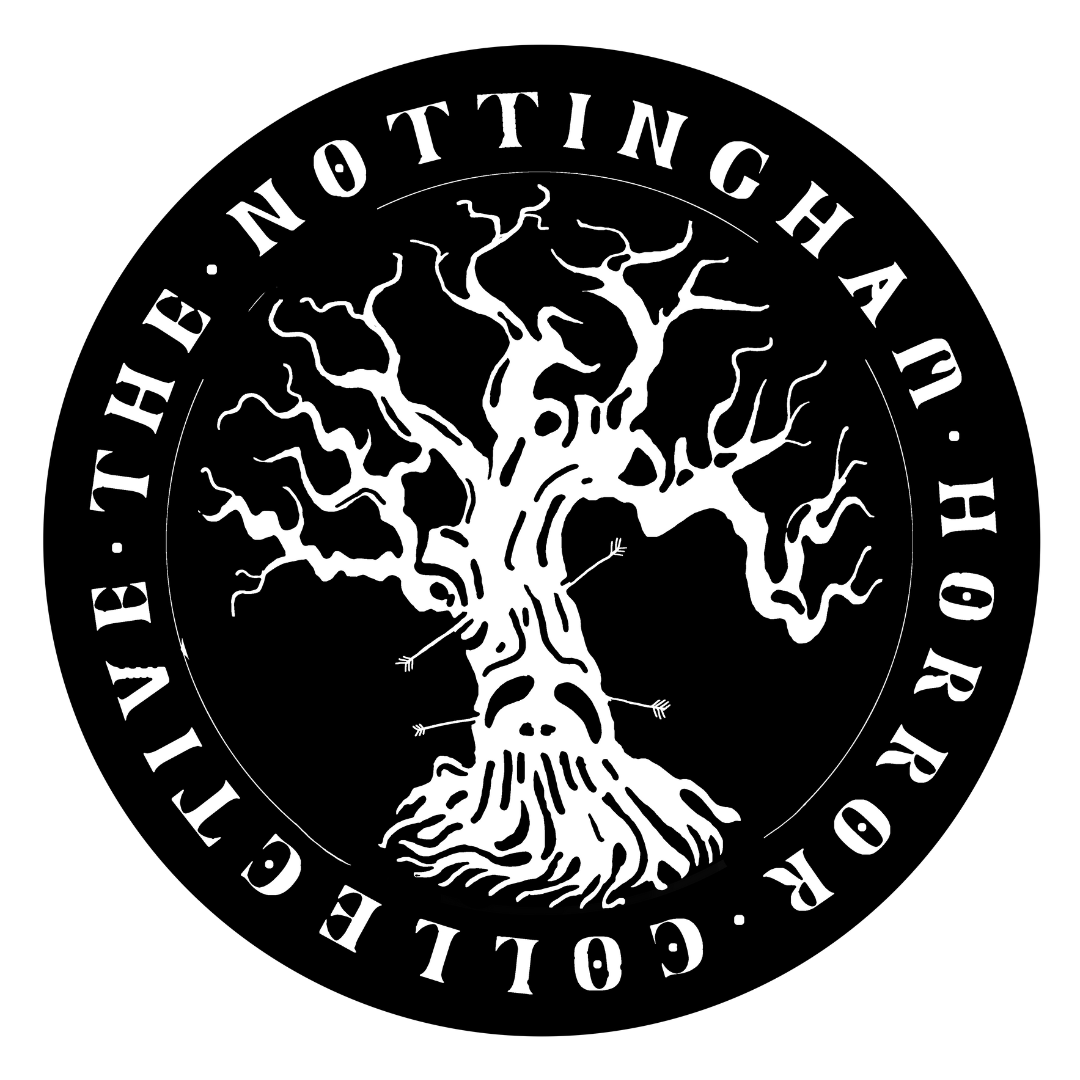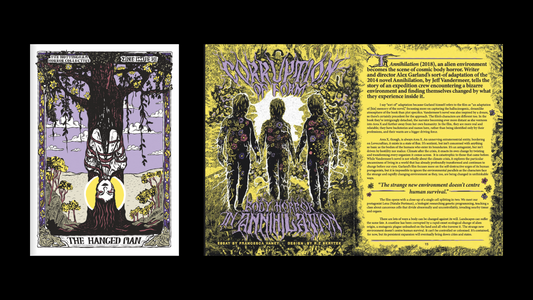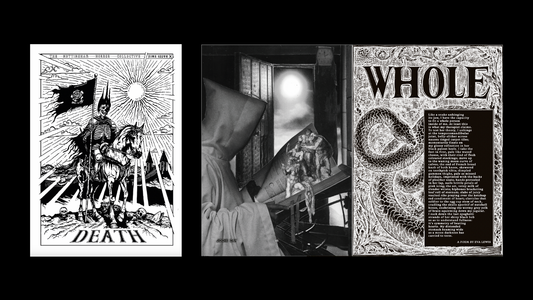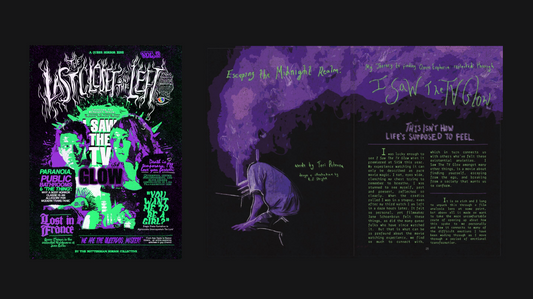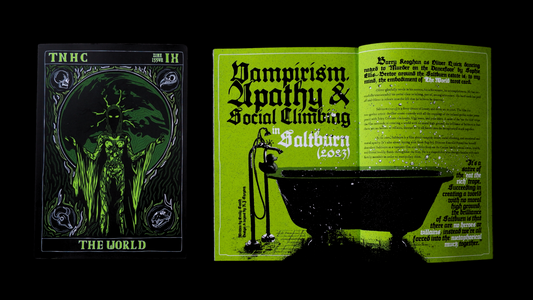The first time I watched that iconic scene in Ringu (1998), it was made 100% worse by the fact it was a Blockbuster VHS tape.
I remember the cold tendrils of dread that slowly crawled up my spine as the eerie black-and-white images flickered on screen. The spine-chilling moments leading up to the sudden appearance of Sadako, the embodiment of J-Horror's ethereal allure. Her long black hair obscuring her face. Her slow, deliberate walk towards the camera. The unmistakable feeling that somehow, despite telling myself this was just a movie, I wasn't safe behind my TV screen.
That sensation of lingering dread, a manifestation of Japan’s rich folklore, is what sets Japanese horror cinema apart from its global counterparts. Let's delve deeper into this cinematic world, tracing its roots and understanding its evolution.
Yurei: Vengeful Spirits
Japanese horror's origins are tangled in the wet, black tresses of traditional ghost stories. As such, it evokes a kind of dread that transcends typical western horror, harking back to an age of ancient beliefs, ethereal beings, and cautionary tales passed down through generations.
The genesis of Japanese horror in cinema can be traced back to its Shinto roots, where folklore was rife with tales of 'Oni', invisible demons wielding formidable powers, capable of causing diseases and natural disasters. Yet, among these spectral beings, the 'yokai' stood out. An umbrella term encapsulating a range of supernatural entities, the 'yokai' further branched out into 'bakemono' (shape-shifters) and the more familiar 'yurei' (vengeful spirits).
An example of the yurei can be seen in an old folk tale about a servent named Okiku who refused her master's romantic advances. And because of his fragile masculinity, he ends up torturing her above a well, eventually killing her and discarding her body into it. But don't worry, because she transforms into a vengeful spirit and comes back to drive him insane. Say it with me now: Good For Her.
The image of the 'yurei', exemplified by haunting figures like Okiku with her disheveled long black hair, embodies an image deeply seared into the psyche of J-Horror enthusiasts. These spirits, often female, were emblematic of vengeance, targeting those who had wronged them in life, driving them to the brink of insanity. But it wasn't until the end of the 19th century, when the Irish folklorist Lafcadio Hearn, enamoured by these tales, began recording them for his 1904 publication "Kwaidan: Stories and Studies of Strange Things", that they transitioned from fireside tales into cinematic masterpieces.

Kaneto Shindo's Onibaba (1964) is hailed as a pioneer, setting a hauntingly evocative tone for what lay ahead. Soon after, Masaki Kobayashi’s anthology film Kwaidan, inspired by Hearn's collection, garnered international acclaim, further establishing the genre’s reputation. Kobayashi’s style, emphasising a lingering dread rather than momentary shocks, set a tone that future Japanese Horror filmmakers would either emulate or consciously deviate from.
Suzuki Sumiko
I want to briefly mention a significant chapter in the history of Japanese horror cinema that's often overlooked, which is the 1930s. These years were crucial in the development of horror as an international genre. While Hollywood made global stars out of Bela Lugosi with Dracula and Boris Karloff with Frankenstein, Japan witnessed the rise of Suzuki Sumiko as its pioneering horror icon.

Contrary to Hollywood’s pattern, where actresses like Fay Wray often portrayed the damsel in distress, Suzuki was more aligned with her male counterparts, Lugosi and Karloff, playing the monstrous entity rather than its victim. Her portrayal of the 'bakeneko' or ‘ghost cat’, a staple of kabuki theatre, blended traditional Japanese motifs with Hollywood horror aesthetics. Like Bela Lugosi's Dracula, Suzuki breathed new life to Japanese monsters that were familiar from woodblock prints and the kabuki stage.
The 1970s
The genre saw a shift during the 70s, embracing campy narratives and surreal presentations epitomised by films like Nobuhiko Obayashi’s psychedelic Hausu (1977). Japan experienced rapid economic growth in the decades following World War II, which culminated in the 1980s. This meant that the 70s saw a period of affluence and heightened consumerism, giving filmmakers more resources and the confidence to experiment. There was also a bit of a rise in independent filmmaking. Without the strict oversight and formulaic requirements of major studios, directors had more freedom to explore unconventional themes and styles.

Hausu stands as one of the most iconic and unorthodox entries in the history of horror cinema. Abandoning the traditional narrative structure and stylistic conventions of its genre, Hausu blends surreal visuals, dark comedy, and avant-garde experimentation to create a nightmarish dreamscape that remains unparalleled. The plot follows a group of schoolgirls who venture to a rural mansion, only to encounter a series of bizarre and increasingly perilous supernatural events.
With its kaleidoscopic use of colours, uncanny special effects, and a narrative punctuated with unexpected moments of levity, Hausu showcases Obayashi's background in experimental filmmaking and adverts. Rather than relying on straightforward scares, the film mesmerises and disorients, cementing its place as a cult classic and a testament to the boundless creativity of 1970s Japanese cinema.
Japanese body horror
Audition (1999) begins as a delicate dance of romantic allure, leading the viewer through a seemingly innocuous tale of a man captivated by a woman embodying traditional Japanese grace. But beneath this serene facade lurks a chilling darkness. The film's brilliance emerges as it abruptly discards its romantic cloak, revealing a nightmarish landscape dominated by our leading lady's sadism.

10 years earlier is when Japanese Cinema ventured into this disturbing realm of body horror, a poignant reflection of societal metamorphosis. Tetsuo: The Iron Man (1989) stands as a chilling testament to this evolution. As we witness the protagonist's agonising transformation into a grotesque fusion of human and machine, we're confronted with a powerful allegory of Japan's tumultuous journey in a rapidly advancing technological age.

Modern Japanese Horror continued to evolve, with directors like Kiyoshi Kurosawa infusing contemporary socio-cultural anxieties into their narratives, as seen in Pulse (2001), a chilling critique on the digital age. And, in paying homage to its roots, films like Ju-on: The Grudge (2002) summoned the lore of vengeful spirits to haunt urban settings, which birthed the term J-Horror by global fans.
J-Horror and its Western Remakes
The late 1990s witnessed J-Horror's meteoric global rise, with films like Hideo Nakata’s Ringu (1998) redefining horror for a new generation, blending the familiar eerie 'yurei' imagery with contemporary settings.
The rise of the vengeful ghost, encapsulated by the iconic Sadako and Kayako, sparked a renaissance that would influence not only Japanese cinema but Hollywood as well, resulting in a slew of remakes.
Ringu, an adaptation of Koji Suzuki's novel, unleashed Sadako's malevolence on unsuspecting viewers. Her haunting appearance, long black hair obscuring her face, became the definitive image of the genre. But, unlike these western remakes, J-Horror cinema refuses to spoon-feed its audience with every nuance.
Rather than opting for a pedantic exposition of its plot, J-Horror revels in the power of the unspoken, often leaving narratives mystifying and elements unexplained. This deliberate obscurity intensifies the atmospheric tension, immersing viewers into an unsettling realm of uncertainty and dread. This stylistic choice starkly contrasts with many Western counterparts, which at times prioritise clarity over atmospheric depth.
The differences between the original Ringu and its American adaptation illuminate this distinction. While the American version offers explanations and resolves ambiguities, the original Ringu plunges us into an enigmatic abyss, making it infinitely more haunting. This commitment to retaining mystery is a testament to J-Horror's belief in the audience's ability to embrace the unknown, which significantly amps up the chill factor.
Technophobia
The digital age has been a boon for many, but in the world of J-Horror, technology has often played the malevolent messenger of doom. Modern Japanese horror films of the late 20th and early 21st century frequently cast technology not just as a tool or backdrop but as a central character – a conduit for the supernatural, turning familiar devices into instruments of dread.

Ringu (1998) became a trailblazer in this sub-genre, where the malignancy is not just the vengeful spirit, Sadako, but the seemingly innocent videotape she haunts. As viewers watched characters perish after viewing the cursed tape, the film taps into a fear that's all too real – the unknowable consequences of rapid technological advancement. It suggests that as we invite technology closer into our lives, we might also be inviting unknown dangers.
The phenomenon continued with films like One Missed Call (2003), where the ubiquitous cellphone becomes an instrument of death. The narrative revolves around a malevolent force that leaves voicemails foretelling the recipient's grim demise. Once again, the line between the convenience of modern technology and its potential for harm is blurred, emphasizing the unease of our over-reliance on digital devices.
Similarly, in Pulse (Kairo, 2001), Kiyoshi Kurosawa crafts an unnerving meditation on the alienation borne from our increasingly digitized existence. As characters encounter a sinister website that brings forth enigmatic shadows, their very essence and will to continue living gets eroded. Amidst a backdrop of technological sterility, Kurosawa paints a chilling portrait of disconnection and existential dread.

Together with cinematographer Jun’ichirô Hayashi, the film plays with light and shade in a meticulously designed dance, compelling viewers to squint through dim corners for things they might regret spotting. Instead of rapid cuts, Kurosawa employs lingering shots that saturate each scene with an impending sense of doom. Beyond its haunting visuals, the most unsettling element of Pulse is its poignant exploration of solitude in an interconnected world.
Such narratives echo genuine concerns about technology's invasive nature and its capacity to isolate rather than connect. By intertwining technological advancement with supernatural horrors, modern J-Horror holds up a distorted mirror to society, forcing us to confront our fears and dependencies in an increasingly digitised world.
J-Horror's Imprint on Global Cinema
The late 90s and early 2000s saw a significant shift in Western horror filmmaking, deeply influenced by the atmospheric dread and unique storytelling techniques emblematic of J-Horror. Films like Ringu not only led to direct American remakes, such as The Ring (2002), but also deeply influenced the overall tonal and stylistic approach of many Western horror films. The Blair Witch Project (1999), for instance, may seem like an all-American found footage horror film, but its reliance on unseen terrors, unsettling ambiance, and the psychological unraveling of its characters mirrors the ethos of J-Horror. And, at a time where Western Horror was being dominated by self-aware teen slashers like Scream, this was incredibly refreshing to see.
The emphasis on psychological horror, nuanced character development, and a preference for unsettling atmosphere over explicit gore became more prominent in the West. Plus, the thematic concerns of J-Horror, especially its cautionary tales about modernity and technology, found resonance within Western audiences. This cultural exchange resulted in a wave of Hollywood productions embracing the chilling subtlety and narrative depth of J-Horror, indelibly marking Western horror cinema and highlighting the global influence of Japan's cinematic terror.
Today, Japanese horror offers a multifaceted cinematic experience, from visceral terror to satirical comedies, embodying an indomitable spirit that draws both from its ancient roots and contemporary influences. It's this delicate balance between old and new, familiar and unfamiliar, that makes Japanese Horror a hauntingly beautiful paradox.
